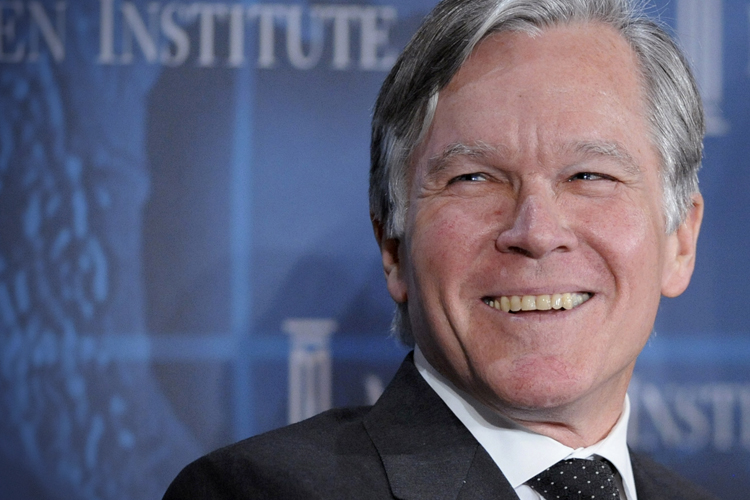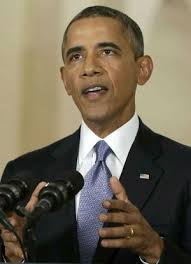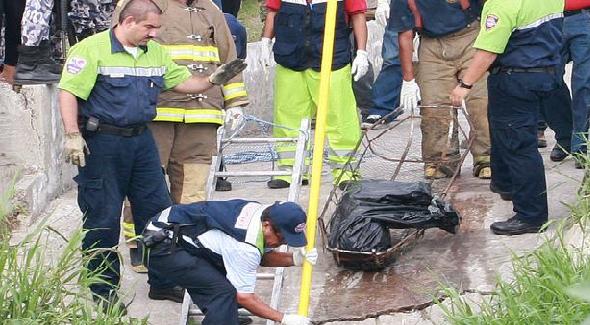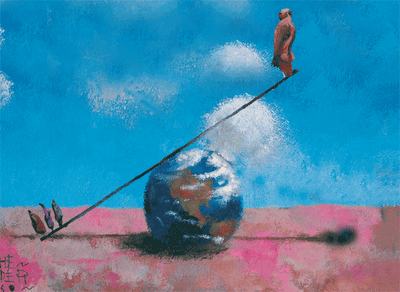TOO MUCH—Chronicles of Inequality [Jan. 20, 2014]
| SPECIAL |
 |
January 20, 2014 |
| THIS WEEK | |
| We’ve been having plenty of speechifying the last few days — and last few years for that matter — about the legacy of Martin Luther King Jr. With Barack Obama in the White House, some posit, we are now living Dr. King’s dream.Phoenix tax analyst Bob Lord begs to differ. We may actually, he suggested last week, be living Dr. King’s nightmare: America’s 400 richest billionaires now hold as much wealth — $2 trillion — as all the nation’s 14 million African-American households combined.Dr. King, Lord reminds us, “stood not only for social justice, but for economic justice as well,” and economist Gar Alperovitz makes the same point in a newly published reflection on his work with Dr. King in the 1960s. We cannot understand why we have so many poor in America, King taught, without raising more fundamental questions about our “broader distribution of wealth.”That distribution mattered to Martin Luther King. That distribution ought to matter to us. Much more on it in this week’s Too Much. | About Too Much, a project of the Institute for Policy Studies Program on Inequality and the Common GoodSubscribe to Too MuchJoin us on Facebook or follow us on Twitter |
| GREED AT A GLANCE | |
The peasants with pitchforks are coming, or so some of America’s wealthiest seem absolutely convinced. Deep-pocket outlays for home security, Forbesreports, have “increased markedly over the last five years.” California’s American Saferoom Door Company is now selling over 50 kevlar-lined, bullet-resistant doors a year, at $20,000 apiece. Another West Coast firm, Strategically Armored & Fortified Environments, is building multi-million-dollar bunkers deep underground that come with their own geothermal power and sustainable food supplies. A wealthy family, notes Forbes, could survive in the best-planned of “these luxurious strongholds for up to three generations.” Sixteen-year-old Ethan Couch, a psychologist told a Texas judge last month, “never learned that sometimes you don’t get your way.” Couch grew up in a wealthy family that lavished him with cars, money, and “freedoms that no young man would be able to handle.” Couch certainly couldn’t. Driving drunk outside Fort Worth, he killed four people busy helping a distressed motorist. At sentencing, Couch’s lawyer declared his client a victim of “affluenza.” The judge agreed, sentenced Couch to probation, and let him flee to a Newport Beach rehab center that will set his folks back $450,000. Last week, to help “ensure that people who come from privileged backgrounds will not get a different type of justice,” state lawmaker Mike Gatto introduced a bill that bans the “affluenza” defense in California’s courtrooms . . .One final prediction for the new year: The Travel Weekly trade journal is forecasting that 2014 “might well go down as a year of limitless luxury.” Travel companies, gushes marketer JoAnn Kurtz-Ahlers, are rolling out more and more “over-the-top products” — “and people are booking them.” At hefty prices. A $1.5 million per-person ticket, for instance, for an eight-seat private jet around-the-world tour. In well-heeled circles, agrees luxury auto dealer Ken Gorin of Florida’s Coral Gables, squeamishness about luxury spending has just about disappeared. Early on in the Great Recession, he notes, rich consumers would “come in and buy, but it would be the same color and the same model so no one knew they got a new car.” And now? Says Gorin: “Doesn’t matter. Yellow cars, blue cars, red cars, white cars, people are feeling better.” Sixteen-year-old Ethan Couch, a psychologist told a Texas judge last month, “never learned that sometimes you don’t get your way.” Couch grew up in a wealthy family that lavished him with cars, money, and “freedoms that no young man would be able to handle.” Couch certainly couldn’t. Driving drunk outside Fort Worth, he killed four people busy helping a distressed motorist. At sentencing, Couch’s lawyer declared his client a victim of “affluenza.” The judge agreed, sentenced Couch to probation, and let him flee to a Newport Beach rehab center that will set his folks back $450,000. Last week, to help “ensure that people who come from privileged backgrounds will not get a different type of justice,” state lawmaker Mike Gatto introduced a bill that bans the “affluenza” defense in California’s courtrooms . . .One final prediction for the new year: The Travel Weekly trade journal is forecasting that 2014 “might well go down as a year of limitless luxury.” Travel companies, gushes marketer JoAnn Kurtz-Ahlers, are rolling out more and more “over-the-top products” — “and people are booking them.” At hefty prices. A $1.5 million per-person ticket, for instance, for an eight-seat private jet around-the-world tour. In well-heeled circles, agrees luxury auto dealer Ken Gorin of Florida’s Coral Gables, squeamishness about luxury spending has just about disappeared. Early on in the Great Recession, he notes, rich consumers would “come in and buy, but it would be the same color and the same model so no one knew they got a new car.” And now? Says Gorin: “Doesn’t matter. Yellow cars, blue cars, red cars, white cars, people are feeling better.” |
Quote of the Week“The greatest myth of our time is the notion that extreme policies harm a small subset of people, such as people of color. These policies harm us all. What we’ve seen in North Carolina and other parts of the country are wealthy extremists playing on the fears of working class and white people.” Rev. William Barber, leader of the Moral Mondays Movement, State of the Dream 2014, January 16, 2014 |
| PETULANT PLUTOCRAT OF THE WEEK | |
 Starbucks CEO Howard Schultz can’t seem to find the love — in anyplace but the Starbucks board of directors. That board last January moved to make Schultz the highest-paid CEO in the Pacific Northwest for the fourth straight year. But Schultz remains deeply despised in Seattle for selling away the city’s pro hoops team after taxpayers refused to build him a new arena. And in San Jose activists are now blasting Starbucks for seeking an exemption from having to pay the city’s $15.78 hourly living wage. Schultz, NerdWallet calculated last month, makes $9,637 an hour, 1,096 times the Starbucks average hourly rate. Looking for a Schultz take on all this? You’ll find one in his 2011 memoir: “I love Starbucks because everything we’ve tried to do is steeped in humanity.” Starbucks CEO Howard Schultz can’t seem to find the love — in anyplace but the Starbucks board of directors. That board last January moved to make Schultz the highest-paid CEO in the Pacific Northwest for the fourth straight year. But Schultz remains deeply despised in Seattle for selling away the city’s pro hoops team after taxpayers refused to build him a new arena. And in San Jose activists are now blasting Starbucks for seeking an exemption from having to pay the city’s $15.78 hourly living wage. Schultz, NerdWallet calculated last month, makes $9,637 an hour, 1,096 times the Starbucks average hourly rate. Looking for a Schultz take on all this? You’ll find one in his 2011 memoir: “I love Starbucks because everything we’ve tried to do is steeped in humanity.” |
Take Action on InequalityTell the San Jose city council that billionaire Howard Schultz and Starbucks can afford to pay baristas a living wage. Urge the council not to exempt Starbucks from the $15.78 San Jose living wage requirement for vendors at the city’s convention center. |
| IMAGES OF INEQUALITY | |
 A surviving manse from France’s royal golden age? Not exactly. This nearly completed new abode, the Chateau des Fleurs, sits in Bel Air, a deep-pocket haunt in Los Angeles County. The owner, an L.A. lawyer and real-estate magnate, has spent five years on the home’s construction. The current value: $100 million. The 60,000-square-foot home features “husband-and-wife wings, with communal rooms where the couple will meet in the middle,” says local realtor Jeffrey Hyland. The typical American home occupies 2,500 square feet. A surviving manse from France’s royal golden age? Not exactly. This nearly completed new abode, the Chateau des Fleurs, sits in Bel Air, a deep-pocket haunt in Los Angeles County. The owner, an L.A. lawyer and real-estate magnate, has spent five years on the home’s construction. The current value: $100 million. The 60,000-square-foot home features “husband-and-wife wings, with communal rooms where the couple will meet in the middle,” says local realtor Jeffrey Hyland. The typical American home occupies 2,500 square feet. |
Web Gem The Economy Hub/ This blog from Pulitzer Prize-winning Los Angeles Timesbusiness columnist Michael Hiltzik regularly spotlightsthe games plutocrats play — and the price the rest of us pay. |
| PROGRESS AND PROMISE | |
| More potholes in your neighborhood lately? Fewer teachers? Local and state governments have axed over 700,000 jobs since the Great Recession took hold in 2008. The most effective pushback against these austerity budget cuts? Public employee unions and allied community groups, notes an acute new analysis fromLabor Notes director Mark Brenner, are realizing that advocates for decent public services “win when they preach ‘tax the rich.’” In both California in 2012 and in Minnesota last May, activists won significant revenue-generating tax increases on incomes over $250,000. In both states, anti-austerity campaigns stressed that those who’ve “benefited from the policies that sparked the financial meltdown — corporations and the rich — must pay for the public deficits it produced.” | Like Too Much? Email this issue to a friend |
| INEQUALITY BY THE NUMBERS | |
 |
Stat of the WeekSince 1960, the average income of households in America’s top 1 percent has more than tripled, after inflation. If the nation’s minimum wage had kept pace with that increase, a New York Times breakdown points out, America’s lowest-paid workers would now be laboring at no less than $22.62 per hour.
|
| IN FOCUS | |
| Defining a Bold New Standard for Fair PayA new Toronto-based campaign is aiming to change the global conversation on CEOs, workers, and the real value of their labor.The 32,400 employees at Goldman Sachs averaged $383,374 each last year, the Wall Street banking giant disclosed last week.Typical employees at Goldman, of course, didn’t take home anything near that $383,374. How much do typical Goldman employees actually make? We don’t know. U.S. banks and corporations don’t have to reveal how much they pay their workers. They do have to reveal how much they pay their top execs.
In 2012, Goldman CEO Lloyd Blankfein took home $26 million. Bank clerks nationally, the University of California at Berkeley’s Labor Center reported last month, only average $24,100 a year. Lloyd Blankfein last year likely took home somewhere close to 1,000 times the pay of his bank’s lowest-paid workers. Elsewhere in America, CEOs at major financial and corporate enterprises are pulling down over 350 times average U.S. worker pay. No other nation sports a pay gap that wide. But other nations are catching up. Canadian CEOs took home 105 times average Canadian pay in 1998. They’re taking home 171 times today. What can we do to reverse these widening gaps? Toronto-based public policy analyst Peter MacLeod has one idea. We need, he says, to start “naming and normalizing” a more rational and equitable standard for who gets what. We need, in effect, to start honoring enterprises that practice fair pay and stop rewarding — with our consumer and tax dollars — those enterprises that are making our societies ever more unequal. Last summer, with support from the Canadian foundation world, MacLeod founded a new international effort to put this new standard in place. His new initiative — Wagemark — has already begun certifying those enterprises that pay “competitive, responsible and sustainable wages.”
This eight-times standard may seem hopelessly utopian in a world where corporations routinely pay executives hundreds of times what they pay workers. But at least 90 percent of all businesses, MacLeod last week told Too Much, are currently operating “in a 15-to-1 or better universe.” The “most conspicuously equitable” of these small- and medium-sized employers make up the initial core of Wagemark-certified organizations. Some of them — like the Bellwoods Brewery — already enjoy wide name recognition, and this spring Wagemark will be announcing many more such enterprises. Wagemark-certified companies, nonprofits, and public agencies have all had an independent accountant or auditor confirm that their organization meets the Wagemark eight-times pay standard. The word about Wagemark’s certification process is beginning to spread. News stories on it have so far appeared in most all the major Canadian news outlets, and last month Upworthy introduced Wagemark to a broader online audience. “This could have huge possibilities,” the Upworthy piece noted, “for folks who want to spend their dollars with companies who actually treat people well.” Some international outreach has begun as well. In Denmark, the nation’s largest newspaper gave Wagemark a front-page coverage that sparked a week of national dialogue, in the press and talk-radio, about equity and pay. In Scandinavia, MacLeod would learn from this discussion, “people don’t find the eight-to-one ratio particularly radical.” And Americans back in the middle of the 20th century, he adds, wouldn’t have considered an eight-times standard all that radical either. Back then, even the largest American corporations seldom had pay divides between top executives and workers that went wider than 30-to-1 — and America prospered. With a relatively narrow corporate pay gap in place, a mass middle class, the world’s first and finest, took root. The American CEO-worker pay gap today is running over 10 times wider than that 30-to-1 of the mid 20th century, and MacLeod regularly runs into apologists for this wider divide. “Are you saying,” he like to ask them, “that executive talent today has become ten times scarcer or ten times more productive than executive talent back then?” No evidence, MacLeod points out, supports that contention. What has changed over the past half-century? Our cultural pay paradigm, how we value workers and their work. Pay differentials that would have seemed unconscionable only a few decades ago now seem business as usual. Wagemark is aiming at nothing less than challenging today’s suffocating sense that pay excess at the top reflects some inalterable market inevitability. But efforts like Wagemark, MacLeod stresses, can never succeed in isolation. “Our executive pay problem,” he explains, “has been growing for decades, and it’s going to take pressure from a lot of different directions to change course.” The folks involved with Wagemark see their work as a complement to campaigns for minimum and living wages and drives to make tax systems more progressive. And they’re also building for the long run. They’ve designed their certification process to be completely self-sustaining. Enterprises seeking the right to showcase their Wagemark status will pay a small fee to go through the certification process. The Wagemark Foundation will be devoting this fee income to maintaining a registry of certified fair-pay employers and commissioning original research on how pay disparities impact the effectiveness of our enterprises. Coordinating all this will be a small Wagemark paid staff. “We’re as much about building a conversation,” Wagemark chairman MacLeod explains, “as an organization.” The Wagemark team has no illusions about Fortune 500 companies getting on line anytime soon to apply for eight-to-one ratio certification. But they do see Wagemark making concrete contributions to a process that gradually ups the heat on corporations that continue to brazenly manufacture inequality. Like this article? Sign up Wagemark hopes to work with city officials, for instance, on incorporating pay ratios into the government procurement process, by giving firms that meet the Wagemark pay ratio standard a leg up in the contract bidding process. “We’re really excited about starting small at the municipal level and then expanding,” says MacLeod. “Check back with us in five years!” Interested in learning more about Wagemark and how your company, nonprofit, or public agency can apply for Wagemark certification? You’ll find completebackground and application information online. And a video, too! |
New Wisdom on WealthThomas Ferguson, Paul Jorgensen, and Jie Chen,How Big Money Keeps Populism at Bay, Naked Capitalism, January 14, 2014. Absurdly top-heavy campaign contributions are reducing politics to a contest between different wings of the top 1 percent.John Atlas and Peter Dreier,The Real Chris Christie Scandal, TPM, January 15, 2014. Enriching the rich. The governor has three times vetoed an income tax hike for New Jersey millionaires.Harold Meyerson, More free trade means more inequality, Washington Post, January 15, 2014. A primer on just how. Dean Baker, David Brooks’ Primitive Defense of the Rich, Center for Economic and Policy Research, January 17, 2014. A demolition of the latest high-profile case for ignoring inequality. Sam Polkjan, For the Love of Money, New York Times, January 19, 2014. A must-read insider look at wealth addiction on Wall Street. Alyssa Battistoni, Alive in the Sunshine, Jacobin, January 2014. How the rich ruin the environment.
Learn more about Too Mucheditor Sam Pizzigati’s new history of the forgotten triumph over America’s original plutocracy. |
| NEW AND NOTABLE | |
| Real Estate and Our Global Really Rich Among these numbers: The world’s 200,000 ultras hold over $5 trillion in real estate, about 3 percent of all the world’s real estate value. Not too shabby for a cohort that makes up only 0.003 percent of the world’s population. |
Like Too Much? Email this issue to a friend who might like to subscribe |
| ABOUT TOO MUCH | |
| Too Much, an online weekly publication of the Institute for Policy Studies | 1112 16th Street NW, Suite 600, Washington, DC 20036 | (202) 234-9382 | Editor: Sam Pizzigati. | E-mail: editor@toomuchonline.org | Unsubscribe. | Subscribe to Too MuchForward to a Friend |








